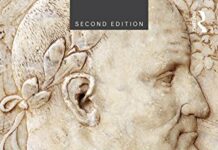
Ebook Info
- Published: 2007
- Number of pages: 290 pages
- Format: PDF
- File Size: 2.91 MB
- Authors: Barbara Levick
Description
This book covers Julia’s life, and charts her travels throughout the Empire from Aswan to York during a period of profound upheaval, and seeks the truth about this woman who inspired such extreme and contrasting views, exposing the instability of our sources about her, and characterizing a sympathetic, courageous, intelligent, and important woman.This book contains a fresh re-assessment of the one of the most significant figures of her time and questions:• Was Julia more powerful than earlier empresses? • Did she really promote despotism? • How seriously is her literary circle to be taken? As part of a dynasty which used force and violence to preserve its rule, she was distrusted by its subjects; as a Syrian, she was the object of prejudice; as a woman with power, she was resented. On the other hand, Domna was the centre of a literary circle considered highly significant by nineteenth-century admirers.
User’s Reviews
Reviews from Amazon users which were colected at the time this book was published on the website:
⭐FIVE stars for LEVICK, -2 for Kindle app and format.EDIT, 2/28/17 KINDLE HAS GOTTEN MUCH WORSE ESPECIALLY IN ITS MOBILE APP for Android. It’s almost impossible to read because the menu won’t show, it unpredicably goes full screen and the book itself doesn’t have a Go to Table of Contents that actually works. There IS a Table of contents, but it’s 20 pages into the book so you have to FIND it to bookmark it, and good luck with that, for the Family Tree gets in the way and obstructs your ability to access the now much-reduced menu of options.YOU CANNOT REMOVE CONTENT FROM THE APP FOR ANDROID, NOR WILL AMAZON LET YOU REMOVE IT FROM THE DEVICE. Who programs these things? That’s a Kindle problem, an app problem, not the problem of the ebook.On a computer, it’s better. But God help you if you try to read this on Android mobile.This review covers the Kindle edition. The Kindle format is MUCH more annoying to use now, than it used to be. Much harder to navigate. That highlight thing is a nuisance, when you just want to mark out text. Its fullscreen is a nightmare, with HUGE GRAY bar in the way, so you’re better off not using fullscreen, or you just size the window yourself. Worse, it won’t stop synching, even when you turn the option off. It won’t show page numbers except arbitrarily, so you can’t quote the pages accurately unless you copy a citation. VERY ANNOYING, KINDLE!!Further, the map and coin pictures in the book are unreadable, in Kindle. God forbid you should complain about these things in the Kindle Forum; the trolls come out and lambast you as if it were YOUR fault Kindle for PC’s program, is now so badly designed. I will have to rethink how many more books I’ll buy, using Kindle format.However, if you’ll need to search the book often, there’s no better alternative.The book, is fabulous. Well-written, well-researched, and Barbara Levick has a keen eye to historical parallels. So when she describes an event during the Severan period, she’s got enough fluent grasp of the ‘big picture’ to compare the parallels with respect to prior and later Roman emperors and their times. Most importantly, instead of just drily relating events and facts as too many Roman historians are wont to do, she folds in the relevant norms, standards, cultural ideas. That matters, for what you need to know about Roman history is WHY. We already have overkill on WHAT.The other big plus of this book, is that she also has a keen recognition of cultural wordplay. So much is misinterpreted in Bible and Roman history, due to ignorance of the rhetorical style, the wit, the laconic deftness, of that age. Being able to interpret the epigraphy — which necessarily specializes in that laconic wit — thus yields fresh insights. She exploits those insights, with skill.So if you’re tired of the typical Roman history review of recited events and movements, recited comparisons with other scholars, you’ll want to buy this book. Read its introduction to see the author’s theses.EDIT: just finished reading the whole book, and I re-rated it down to 3.5 stars. 1 star down, is due to the maps being unreadable (can’t zoom them or flip them out into a window or photo viewer you can zoom). Roman historians have a command of the material, and for them to cite locations is as natural as for the layman to recite the alphabet. So if you don’t know the locations, you quickly lose track of what the writer means, and tune out. So maps are necessary. Each book supplies its own maps, as the places referenced won’t necessarily be the same as a generic map you find in a textbook or on the internet. So this is a serious failing, in the Kindle edition, to have maps with print way too small to read.The remaining half-point down, is due to the author’s not proving her theses. Then again, the theses might not be hers, but rather others’, since the theses are standard historian positions for the period: the mystique of the immediate Severan family, the mystique of Domna’s own family, and the ‘orientalization’ of Roman Religion allegedly taking place DUE TO the Severans.Levick more or less affirms that the Severan mystique was cultivated (invented), giving benefit of the doubt to Domna’s being part of the Royal Emesenes, yet shows there is no real proof for that. There is doubtful proof of the priesthood connection, in prior generations, with ‘Bassianus’ being key; but in Rome, that was a family name, not necessarily the priestly connotation it would have in the language of Domna’s home town.The family itself, whether truly part of Domna’s lineage or not, did have a certain influence. Levick traces that influence and its history.Thirdly, the ‘orientalization’ she means to refute, in the process clarifying that rather the cult of Sol was not an issue until Elagabalus, and even then, it was reviled by many. However, the Eastern cults did grow and multiply during the time, but apart from Severan influence (though sometimes, with their sponsorship).Her main goal was to refute Dio and those others who ascribed to Domna a behind-the-scenes ‘control’ of government. Levick builds her arguments as counterpoints against Dio (and those later historians who side with him), essentially. She finds nothing to justify Dio’s accusation of Domna wielding undue power, a verboten idea in a Roman society long chafing, at how Cleopatra made Anthony a lapdog.She also builds her arguments around the coins, inscriptions, and other epigraphic evidence of the period, in effect concluding that Domna was a thoroughly Roman matron, along with her elder sister Maesa. The latter’s daughters are another matter; apparently they did try to wield power, as regents for their respective sons. Even so, Levick seems to account them as having little influence or effect, whether short- or long-term. This is at variance with typical scholarship, which she accounts as due to prejudice (against ‘oriental’ and against women).I found her counter arguments weak, viz., that since the epigraphic evidence doesn’t show a Domna manipulating things behind the scenes, it must not be true. Okay, then how does she account for Dio’s hostility? To just chalk it up to Dio being prejudiced against non-Romans, against women? Dio isn’t universally hostile to all the Imperator wives. So why single out Domna?See: when history accounts someone as ‘controversial’, there’s a reason. Perhaps the person was more competent than the detractors would like; perhaps less so. Perhaps the person had a charismatic personality, which by nature polarizes the ‘audience’ around whom that person exists. Rightly or wrongly accused, Domna wasn’t like other Imperial wives in some way. Levick praises the woman a lot, but the epigraphic evidence Levick presents, doesn’t support that praise, either. Pity.I was hoping she’d answer the question: how was it, that a rich child like Domna, would be brokered off in marriage, to a mid-level Roman like Severus, especially if the child was 13-19 years old? That’s not Syrian practice at all, especially if they were Arab and rich. And if royal, NO WAY would they marry her off to a commoner, especially a lower-level one like Severus. However, Birley’s book at Location 1071 in Kindle — I don’t know the page number, it’s at the very end of Chapter 4, and stupid Kindle won’t stop synching since I’m online to write this review) — Birley believes Severus when age 25, entered the Senate via quaestorship. His book is ‘Septimius Severus: The African Emperor (Roman Imperial Biographies)’. It’s here in Amazon, and I’m renting it.So Severus at marriage to Domna, is middle-aged, not as wealthy as could be desired; but if a Senator, maybe a worthy catch, in the minds of Domna’s family. Especially, if they didn’t like her.Granted, he found her by means of a horoscope, and he’d want a rich wife who’s young, as he had ambitions. But at the time there was nothing special about Severus that would justify the union. He had a mid-level position, was much older than she so ostensibly had little prospects for upward movement, and he was VERY far away. So was she a troublesome woman no one would marry? Was someone in the family jealous of her, so the match was meant as a punishment or a way to get rid of her? Those questions remain unanswered.Now, maybe you won’t want to read what else I’ll write, so you can stop reading now. For my interest in this book is quite specific and arcane. I’m trying to understand why Paul and Peter meter ‘tag’ the Severans in Bible’s Ephesians 1:9 and 1Peter1:6, respectively. Bible meter is unknown to Christian and other scholars, though its tradition can be easily discerned from Psalm 90 forward, if you just count the syllables and notice how passages like Psalm 90, syntactically ‘break’ in units of SEVEN (=promise, in Hebrew). The style is very specifc and sophisticated. So far I can discern 30 style characteristics, see my BibleHebMeterCharacs(dot)htm on brainout(dot)net .This same rhetorical meter style is employed by the NT Greek writers, the first long instance of it being the Magnificat, on which Paul and Peter, play. Since the meter is used like a future ANNUAL calendar of history, Paul and Peter (who plays on Paul’s meter) plotted out the future of CHURCH.Which brings me to this book: their meter highlights two periods of what to us is now past, Roman history: the Severans, and Diocletian-Constantine. Paul uses Church pregnancy word ‘musterion’ to highlight the SECOND Severan period in Ephesians 1:9, which surprised me. In the metered timeline, Septimus Severus dies JUST BEFORE the beginning of the word ‘musterion’. Which therefore means, a shift to the WOMEN. Yeah, and Church is Bride of Christ, also a ‘mystery’, Paul’s byline in all his letters, his ‘job’ to communicate. Of course, that very year was when the African and Roman apostate branches in Church, began courting the Severan WOMEN, even to the extent of inventing a Peter as a bishop in Rome during the very years he wouldn’t be allowed to go there (Claudius banned the Jews).I didn’t know there were strong women running the show then. (Because, I didn’t study Ancient Rome much, after Domitian.) So this book is vital to understanding WHY Paul did his meter that way.If it matters, I’ve been making videos on the topic for three years, see my Ephesians1REPARSED doc or htm (or Eph1DecreeSyllablesREPARSED pdf) for details. I just learned of Peter’s meter two weeks prior, hence needed to buy this book to understand why they target the Severans.For this book, like Bishop Lists by Robert Lee Williams (see my review here in Amazon and my video reviews with permissions from the publisher in Youtube or vimeo) — this book, shares a common theme: FAKE PEDIGREE. Here, fake pedigree of the Severans.Thus I know better why Paul and Peter satirize the period. For this was when the fake pedigree of Church was invented by Irenaeus, Tertullian, and Demetrius of Alexandria (see the Bishop Lists book on that).Yet a fake pedigree was ALSO the basis for Septimus Severus’ rise to power. His own, and that of his wife. How much was fake versus how much exaggerated, is in some dispute. The author of this book goes through what evidence she can find, to separate claim from fact. Point is, that money alone wasn’t enough to legitimate their rule. They cultivated what became an ‘orientalized’ trend in Roman politics and culture, which remained characteristic of the Empire. Levick disputes that, claiming that the Severans were thoroughly Roman. Okay, maybe they didn’t sponsor it altogether, as the evidence she furnishes seems instead to indicate a grass-roots popularity of orientalized god-notions, principally the idea behind monotheism, ONE Deity To Rule Them all.In any event, orientalization brought with it profound changes in the concept of empire, of rule. Since Diocletian grew up under this very change, and since Constantine would continue all of Diocletian’s policies wholesale; since Roman Catholicism is the exact product of those ideas, this book is instrumental in understanding how that outcome, came to be.Best of all, 1/3 of the book is devoted to bibliography, notes, glossary, so you can do further reading.
⭐The author is a distinguished historian, who has written some fine biographies of Roman emperors, especially the definitive book on Tiberius. As one would expect from her, the book ranges over a wide body of evidence – literary, archaeological, numismatic, epigraphic – and carefully and convincingly sifts through what is known and what is unknown. No doubt it is the best (only?) biography of Julia Domna available. However, there simply isn’t enough known about Julia Domna to support a book, so it ends up being primarily filled with disjointed digressions about the Severan age.A reader who wants to understand the outlines of Julia Domna’s life can find almost all the known facts from more accessible sources: Grant’s book The Severans: The Roman Empire Transformed, or Birley’s book Septimius Severus: The African Emperor, and even online bios (again, the known facts are quite limited). The reader of this book will certainly not come away with an understanding of Julia Domna’s personality or motives. Indeed, the strongest part of the book is showing that much of what is claimed to be known about her motives and actions is an invention of later historians, unsupported by the evidence. I felt more informed after the reading the book, but paradoxically, Julia Domna the person felt more unknown to me than before.The other problem is the writing style, which needed an editor. The text jumps around from topic to topic in an unpredictable way that often left me confused. I repeatedly found myself having to re-read sentences and return to the beginning of a paragraph once I had the reached the end to figure out what the author meant. To give the flavor, here is a quote: “The ‘Orientalism’ of Edward Said’s French and British scholars, which aimed at control, was inverted, or rather bypassed, and Graeco-Roman fears were picked up and reflected.” (This is first and only mention of Edward Said in the book, by the way.) The reader has to struggle through sentences like this on every page.I do think this book is a useful contribution to knowledge. We need scholars to assemble the evidence and piece together the story as best they can. And I learned some things – for example, I was persuaded that the Orientalizing tendency of the Severans has been overplayed. In the end, though, there isn’t enough known about Julia Domna to justify a book for the general reader. This one will be essential to Roman history scholars, but Roman hobbyists and general readers will find it a slog.
⭐Dis is a very so much good boack. As a Muslim Arab woman I’m very excited right now to know that I know an empress princess was a Muslim Arab from Soyra who converted an infidel Jewish emperor to Islam in 2second sentury . Inshallah
⭐I believe this book is the only modern monograph devoted to Julia Domna, wife of the pivotal Roman emperor Septimius Severus and mother of the disappointing emperor Caracalla. During her tenure as Augusta, she built a base of power for herself, her sister and her nieces, collectively known as the Four Julias or the Syrian Princesses. There are many claims and accusations made about Julia Domna in ancient sources and Barbara Levick reviews some of the most common, although she doesn’t seem to legitimate the claim of Julia marrying Caracalla as alleged in the notoriously unreliable and biased Historia Augusta.Levick covers some of the other important claims about her literary salon and her senate of women. Julia Domna and her family are some of the most interesting women in the history of the Third Century.
⭐fast delivery great book
⭐It is a very interesting book on one of the most influential women in the history of Rome.
Keywords
Free Download Julia Domna: Syrian Empress (Women of the Ancient World) 1st Edition in PDF format
Julia Domna: Syrian Empress (Women of the Ancient World) 1st Edition PDF Free Download
Download Julia Domna: Syrian Empress (Women of the Ancient World) 1st Edition 2007 PDF Free
Julia Domna: Syrian Empress (Women of the Ancient World) 1st Edition 2007 PDF Free Download
Download Julia Domna: Syrian Empress (Women of the Ancient World) 1st Edition PDF
Free Download Ebook Julia Domna: Syrian Empress (Women of the Ancient World) 1st Edition



